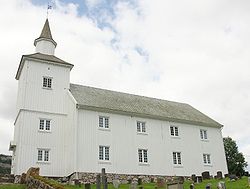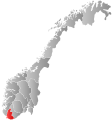Fjotland (municipality)
Fjotland herred | |
|---|---|
 View of the municipal church | |
 Vest-Agder within Norway | |
 Fjotland within Vest-Agder | |
| Coordinates: 58°31′30″N 06°59′34″E / 58.52500°N 6.99278°ECoordinates: 58°31′30″N 06°59′34″E / 58.52500°N 6.99278°E | |
| Country | Norway |
| County | Vest-Agder |
| District | Lister |
| Established | 1838-1841 |
| Re-established | 1 Jan 1858 |
| Disestablished | 1 Jan 1963 |
| Administrative centre | Fjotland |
| Area | |
| • Total | 600 km2 (200 sq mi) |
| *Area at municipal dissolution. | |
| Population (1963) | |
| • Total | 1,244 |
| • Density | 2.1/km2 (5.4/sq mi) |
| Time zone | UTC+01:00 (CET) |
| • Summer (DST) | UTC+02:00 (CEST) |
| ISO 3166 code | NO-1036 |
| Created as | Formannskapsdistrikt in 1838 |
| Succeeded by | Kvinesdal in 1841 |
| Preceded by | Kvinesdal in 1858 |
| Succeeded by | Kvinesdal in 1963 |
Fjotland is a former municipality in the old Vest-Agder county, Norway. The 600-square-kilometre (230 sq mi) municipality existed from 1838 until 1841 and again from 1858 until its dissolution in 1963. The administrative centre was the village of Fjotland where Fjotland Church is located. The municipality covered the northern part of the valley in the present-day municipality of Kvinesdal.[1]
History[]
The parish of Fjotland was established as a municipality on 1 January 1838 (see formannskapsdistrikt law), but the municipality was short-lived. In 1841, Fjotland (population: 980) was merged into the neighboring municipality of Kvinesdal. This union, however, only lasted until 1858 when Fjotland was separated to form its own municipality again. At that time, Fjotland had a population of 1,044.
On 1 January 1874, an unpopulated area of Fjotland was transferred to neighboring Sirdal municipality. On 1 January 1903, a small area of Sirdal (population: 63) was transferred to Fjotland. During the 1960s, many Norwegian municipalities were consolidated due to the work of the Schei Committee. On 1 January 1963, Fjotland (population: 1,244) was dissolved and it was merged with Kvinesdal (again) and Feda municipality to form a new, larger municipality of Kvinesdal.[2]
Name[]
The name of the municipality (originally the parish) comes from the old Fjotland farm (Old Norse: Fjósaland). The first element in the name comes from the word fjøs which means "barn" and the last element in the name comes from the word land which means "land".[3]
Government[]
All municipalities in Norway, including Fjotland, are responsible for primary education (through 10th grade), outpatient health services, senior citizen services, unemployment and other social services, zoning, economic development, and municipal roads. The municipality was governed by a municipal council of elected representatives, which in turn elected a mayor.[4]
Municipal council[]
The municipal council (Herredsstyre) of Fjotland was made up of representatives that were elected to four year terms. The party breakdown of the final municipal council was as follows:
| Party Name (in Norwegian) | Number of representatives | |
|---|---|---|
| Christian Democratic Party (Kristelig Folkeparti) | 8 | |
| Centre Party (Senterpartiet) | 4 | |
| Liberal Party (Venstre) | 5 | |
| Total number of members: | 17 | |
| Party Name (in Norwegian) | Number of representatives | |
|---|---|---|
| Labour Party (Arbeiderpartiet) | 6 | |
| Christian Democratic Party (Kristelig Folkeparti) | 4 | |
| Farmers' Party (Bondepartiet) | 3 | |
| Liberal Party (Venstre) | 3 | |
| Local List(s) (Lokale lister) | 1 | |
| Total number of members: | 17 | |
| Party Name (in Norwegian) | Number of representatives | |
|---|---|---|
| Labour Party (Arbeiderpartiet) | 3 | |
| Christian Democratic Party (Kristelig Folkeparti) | 4 | |
| Farmers' Party (Bondepartiet) | 3 | |
| Liberal Party (Venstre) | 2 | |
| Local List(s) (Lokale lister) | 4 | |
| Total number of members: | 16 | |
| Party Name (in Norwegian) | Number of representatives | |
|---|---|---|
| Labour Party (Arbeiderpartiet) | 4 | |
| Christian Democratic Party (Kristelig Folkeparti) | 4 | |
| Local List(s) (Lokale lister) | 8 | |
| Total number of members: | 16 | |
| Party Name (in Norwegian) | Number of representatives | |
|---|---|---|
| Labour Party (Arbeiderpartiet) | 9 | |
| Joint list of the Liberal Party (Venstre) and the Radical People's Party (Radikale Folkepartiet) | 4 | |
| Local List(s) (Lokale lister) | 3 | |
| Total number of members: | 16 | |
| Party Name (in Norwegian) | Number of representatives | |
|---|---|---|
| Labour Party (Arbeiderpartiet) | 6 | |
| Farmers' Party (Bondepartiet) | 4 | |
| Liberal Party (Venstre) | 6 | |
| Total number of members: | 16 | |
See also[]
References[]
- ^ Store norske leksikon. "Fjotland – tidligere kommune" (in Norwegian). Retrieved 14 September 2016.
- ^ Jukvam, Dag (1999). "Historisk oversikt over endringer i kommune- og fylkesinndelingen" (PDF) (in Norwegian). Statistisk sentralbyrå.
- ^ Rygh, Oluf (1912). Norske gaardnavne: Lister og Mandals amt (in Norwegian) (9 ed.). Kristiania, Norge: W. C. Fabritius & sønners bogtrikkeri. p. 276.
- ^ Hansen, Tore, ed. (12 May 2016). "kommunestyre". Store norske leksikon (in Norwegian). Kunnskapsforlaget. Retrieved 21 November 2020.
- ^ "Kommunevalgene og Ordførervalgene 1959" (PDF) (in Norwegian). Oslo: Statistisk sentralbyrå. 1960. Retrieved 21 November 2020.
- ^ "Kommunevalgene og Ordførervalgene 1955" (PDF) (in Norwegian). Oslo: Statistisk sentralbyrå. 1957. Retrieved 21 November 2020.
- ^ "Kommunevalgene og Ordførervalgene 1951" (PDF) (in Norwegian). Oslo: Statistisk sentralbyrå. 1952. Retrieved 21 November 2020.
- ^ "Kommunevalgene og Ordførervalgene 1947" (PDF) (in Norwegian). Oslo: Statistisk sentralbyrå. 1948. Retrieved 21 November 2020.
- ^ "Kommunevalgene og Ordførervalgene 1945" (PDF) (in Norwegian). Oslo: Statistisk sentralbyrå. 1947. Retrieved 21 November 2020.
- ^ "Kommunevalgene og Ordførervalgene 1937" (PDF) (in Norwegian). Oslo: Statistisk sentralbyrå. 1938. Retrieved 21 November 2020.
- Kvinesdal
- Former municipalities of Norway
- 1838 establishments in Norway
- 1840s disestablishments in Norway
- 1848 establishments in Norway
- 1963 disestablishments in Norway


